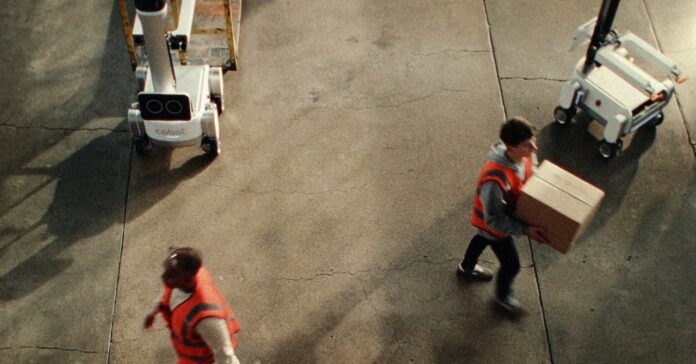Brad Porter knows a few things about putting robots to work. Between 2017 and 2020, he led a push at Amazon to develop a new range of smarter, more adaptive, artificial-intelligence-powered warehouse robots.
These machines, which include robotic arms capable of seeing and grasping items from conveyors, and mobile robots that work in close proximity to humans, have allowed Amazon to redesign its fulfillment centers to be more automated. They’ve also accelerated processing and delivery times, and—of course—improved profit margins.
Porter now leads Cobot, a company that aims to help other companies increase their robotic workforces, too. Cobot’s first product is Proxie, a two-armed, four-wheeled warehouse robot that looks a bit like a mobile hatstand. The robot, which has a touchscreen face and a sensors on a head-high mast, is designed to assist, initially, with the mundane but very common work of moving trolleys stacked with items around offices, airports, hospitals, and factories.
“The vision is for trustworthy cobots to be ubiquitous, working alongside humans in every sector,” Porter says.
Some 30 Proxie robots are currently being tested by the shipping company Maersk and by the Mayo Clinic. The robots have completed more than 5,000 hours’ total operating time, moving 16,000 carts and logging more than 1,000 kilometers of travel. Several other companies, including Moderna, Owens & Minor, and Tampa General Hospital, are exploring how they might use Proxies.
Unlike other robots, Proxie’s battery can be swapped out to avoid downtime charging. Cobot declined to say how much Proxie costs to buy or lease, but mobile robots often cost tens of thousands of dollars a piece.
The robots work alongside humans, taking turns moving carts and navigating busy spaces without running into anyone. Porter says the idea is for the robots to level up as AI becomes more capable, allowing for more sophisticated manipulation and communication.
Cobot has a version of Proxie that will respond to voice commands using a large language model to parse utterances, Porter says. When a worker says “Go to dock 3 and grab the cart by the door,” the robot will respond accordingly. The company is also tracking the development of algorithms that allow for more sophisticated forms of manipulation.
Proxie might seem remarkably simple at a time when many companies are rushing to develop humanoid robots. But Porter says while Amazon is working with one startup, Agility Robotics, to test its humanoid robot, the technology is simply too expensive and raw to be deployed widely, he says. Some humanoids on the market cost tens of thousands of dollars while others cost many hundreds of thousands. But autonomous capabilities vary wildly, as does reliability, making them more costly to deploy.
“At Amazon, we looked a lot at humanoids,” Porter says. “There are real problems to be solved with something more human capable, but jumping all the way to a humanoid is super complicated. The AI, it’s not really there yet.”
Instead, Proxie could replace more and more menial tasks that human beings often don’t want to do. Erez Agmoni, a general partner at Interwoven Ventures who was involved with bringing the Cobot pilot to Maersk, says it has been very promising and has the potential to be expanded.
“The main reason is their ability to utilize collaborative robots to support the teams without huge modifications to the warehouse or current equipment,” he says. “The team hated pushing the carts, which are very heavy, and they welcome the robots doing it.”
Fady Saad, founder of Cybernetix, a Boston-based venture capital firm specializing in robotics, says Cobot is going after a big new category of labor involving moving goods around on trolleys that can be tackled using recent robotics advances. He adds that it is important Proxie can evolve into something more capable.
“Porter is trying to build a platform that could evolve into a humanoid down the road,” Saad says. “I think that’s the right approach.”
Porter is not the only robotics luminary to be pursuing something simpler than humanoids. Rodney Brooks, a pioneering researcher and cofounder of iRobot, is now the chief technology officer of Robust.AI, a company that makes collaborative mobile robots capable of helping human pickers inside factories and warehouses.
“There’s a real need in factories and warehouses for moving things around, but thinking humanoids are going to do it anytime soon is just craziness,” Brooks says. “Wheels were invented for a good reason.”
What sorts of menial tasks would you like a robot to help you do? Would it make a difference to you if the robot were humanoid or not? Write to me at hello@wired.com to let me know.
Source : Wired













